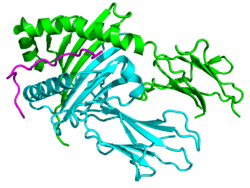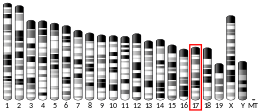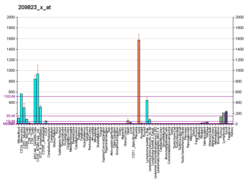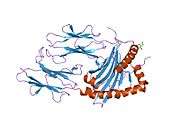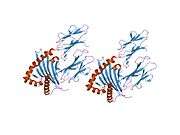HLA-DQB1
Major histocompatibility complex, class II, DQ beta 1, also known as HLA-DQB1, is a human gene and also denotes the genetic locus that contains this gene.[5] The protein encoded by this gene is one of two proteins that are required to form the DQ heterodimer, a cell surface receptor essential to the function of the immune system.
Function
HLA-DQB1 belongs to the HLA class II beta chain paralogues. This class II molecule is a heterodimer consisting of an alpha (DQA) and a beta chain (DQB), both anchored in the membrane. It plays a central role in the immune system by presenting peptides derived from extracellular proteins. Class II molecules are expressed in antigen-presenting cells (APC: B lymphocytes, dendritic cells, macrophages).[5]
Gene structure and polymorphisms
The beta chain is approximately 26-28 kDa and it contains 6 exons. Exon one encodes the leader peptide, exons 2 and 3 encode the two extracellular protein domains, exon 4 encodes the transmembrane domain, and exon 5 encodes the cytoplasmic tail. Within the DQ molecule, both the alpha chain and the beta chain contain the polymorphisms specifying the peptide binding specificities, resulting in up to 4 different molecules. Typing for these polymorphisms is routinely done for bone marrow transplantation.[5][6]
Disease association
Diabetes
Several alleles of HLA-DQB1 are associated with an increased risk of developing type 1 diabetes.[7][8][9] The locus also has the genetic name IDDM1 as it is the highest genetic risk for type 1 diabetes. Again the DQB1*0201 and DQB1*0302 alleles, particularly the phenotype DQB1*0201/*0302 has a high risk of late onset type 1 diabetes. The risk is partially shared with the HLA-DR locus (DR3 and DR4 serotypes).
Celiac disease
Celiac1 is a genetic name for DQB1, the HLA DQB1*0201, *0202, and *0302 encode genes that mediate the autoimmune coeliac disease. Homozygotes of DQB1*0201 have a higher risk of developing the celiac disease, relative to any other genetic locus.[10]
Multiple sclerosis
Certain HLA-DQB1 alleles are also linked to a modest increased risk of multiple sclerosis.[11][12]
Narcolepsy
Other HLA-DQB1 alleles are associated with a predisposition to narcolepsy,[13] specifically HLA-DQB1*0602, which is carried by over 90% of patients with narcolepsy-cataplexy.[14]
Alleles
| Serotype | DQB1 allele |
|---|---|
| DQ2 | *0201 |
| *0202 | |
| *0203 | |
| DQ4 | *0401 |
| *0402 | |
| DQ5 | *0501 |
| *0502 | |
| *0503 | |
| *0504 | |
| DQ6 | *0601 |
| *0602 | |
| *0603 | |
| *0604 | |
| *0605 | |
| *0609 | |
| DQ7 | *0301 |
| *0304 | |
| DQ8 | *0302 |
| *0305 | |
| DQ9 | *0303 |
References
- ENSG00000206237, ENSG00000231286, ENSG00000206302, ENSG00000179344, ENSG00000231939, ENSG00000225824 GRCh38: Ensembl release 89: ENSG00000233209, ENSG00000206237, ENSG00000231286, ENSG00000206302, ENSG00000179344, ENSG00000231939, ENSG00000225824 - Ensembl, May 2017
- GRCm38: Ensembl release 89: ENSMUSG00000073421 - Ensembl, May 2017
- "Human PubMed Reference:". National Center for Biotechnology Information, U.S. National Library of Medicine.
- "Mouse PubMed Reference:". National Center for Biotechnology Information, U.S. National Library of Medicine.
- "Entrez Gene: HLA-DQB1 major histocompatibility complex, class II, DQ beta 1".
- Lau M, Terasaki PI, Park MS (1994). "International Cell Exchange, 1994". Clinical Transplants: 467–88. PMID 7547576.
- Todd JA (April 1990). "Genetic control of autoimmunity in type 1 diabetes". Immunology Today. 11 (4): 122–9. doi:10.1016/0167-5699(90)90049-F. PMID 2187469.
- Todd JA (March 1997). "Genetics of type 1 diabetes". Pathologie-Biologie. 45 (3): 219–27. PMID 9296067.
- Redondo MJ, Fain PR, Eisenbarth GS (2001). "Genetics of type 1A diabetes". Recent Progress in Hormone Research. 56: 69–89. doi:10.1210/rp.56.1.69. PMID 11237226.
- Murray JA, Moore SB, Van Dyke CT, Lahr BD, Dierkhising RA, Zinsmeister AR, Melton LJ, Kroning CM, El-Yousseff M, Czaja AJ (December 2007). "HLA DQ gene dosage and risk and severity of celiac disease". Clinical Gastroenterology and Hepatology. 5 (12): 1406–12. doi:10.1016/j.cgh.2007.08.013. PMC 2175211. PMID 17919990.
- Dyment DA, Sadovnick AD, Ebers GC, Sadnovich AD (1997). "Genetics of multiple sclerosis". Human Molecular Genetics. 6 (10): 1693–8. doi:10.1093/hmg/6.10.1693. PMID 9300661.
- Schmidt H, Williamson D, Ashley-Koch A (May 2007). "HLA-DR15 haplotype and multiple sclerosis: a HuGE review". American Journal of Epidemiology. 165 (10): 1097–109. doi:10.1093/aje/kwk118. PMID 17329717.
- Kadotani H, Faraco J, Mignot E (May 1998). "Genetic studies in the sleep disorder narcolepsy". Genome Research. 8 (5): 427–34. doi:10.1101/gr.8.5.427. PMID 9582188.
- "Narcolepsy Research - FAQs".
External links
- Overview of all the structural information available in the PDB for UniProt: P01920 (HLA class II histocompatibility antigen, DQ beta 1 chain) at the PDBe-KB.
